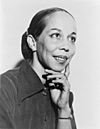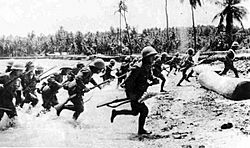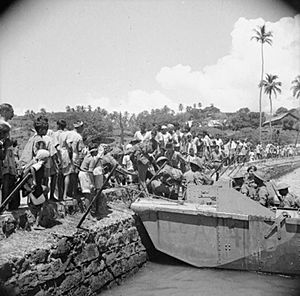Japanese occupation of the Andaman and Nicobar Islands facts for kids
The Japanese occupation of the Andaman and Nicobar Islands occurred in 1942 during World War II. The Andaman and Nicobar Islands (8,293 km2 on 139 islands), are a group of islands situated in the Bay of Bengal at about 1,250 km (780 mi) from Kolkata, 1,200 km (750 mi) from Chennai and 190 km (120 mi) from Cape of Nargis in Burma. Until 1938 the British government used them as a penal colony for Indian and African political prisoners, who were mainly put in the notorious Cellular Jail in Port Blair, the biggest town (port) on the islands. Today they form a Union Territory of India.
The only military objective on the islands was the city of Port Blair. The garrison consisted of a 300-man Sikh militia with 23 British officers, augmented in January 1942 by a Gurkha detachment of 4/12th Frontier Force Regiment of the 16th Indian Infantry Brigade. Following the fall of Rangoon on March 8, however, the British recognized that Port Blair had become impossible to defend, and on March 10 the Gurkhas were withdrawn to the Arakan peninsula.
Contents
Invasion force
The Japanese, seeking to secure their seaward flank, dispatched a force to seize the islands. The force was composed of the following units and ships:
Distant Cover
-
- Cruiser (flagship) Chokai
- Carrier Division 4
- Carrier Ryūjō (although listed, she did not conduct air operations)
- Cruiser Division 7 – Heavy cruisers
- Kumano
- Suzuya
- Mikuma
- Mogami
- Destroyer Division 11
- Fubuki
- Hatsuyuki
- Shirayuki
- Murakami
Close Cover
- Destroyer Squadron 3
- Light cruiser Sendai
- Destroyer Division 19
- Isonami
- Uranami
- Ayanami
- Destroyer Division 20
- Amagiri
- Asagiri
- Yugiri
- Shirakumo
Invasion Force
-
- Light cruiser Yura – escort unit
- 9 Transports
-
- 1 Battalion from 18th Infantry Division
- 9th Base Force
- Training cruiser Kashii
- Escort ship Shumushu
- Minelayer Hatsutaka
- Converted gunboat Eiko Maru
Minesweeper Division 1
-
- Minesweepers W1, W3, W4
Special Minesweeper Division 91
-
- Minesweepers: Choko Maru, Shonan Maru No. 7, Shonan Maru #5
Air Unit
-
- Seaplane tender Sagara Maru (operated east of the Nicobars)
Japanese occupation
Port Blair was occupied on the 23 March 1942. The garrison offered no resistance to the landings, and were disarmed and interned; many of the Sikh militia later enlisted in the Indian National Army. The British militia officers were sent to Singapore as POWs, whilst Chief Commissioner Waterfall, Deputy Commissioner Major A.G. Bird and the other British administrative officers were imprisoned. The Japanese released the prisoners held in the jail, one of whom, Pushkar Bakshi, became their principal collaborator. The islands were put under the authority of Colonel Bucho of the INA, whilst a number of junior Indian officials in the administration were elevated to more responsible posts. The defence of the islands was assigned to the newly formed fighter squadron of the Kanoya Kōkūtai based at Tavoy in southern Burma. This fighter squadron was the former "Yamada Unit" under the control of the 22nd Koku Sentai, then based at Penang. Six flying boats from the Toko Kōkūtai were dispatched on March 26, with twelve more arriving shortly thereafter. Within the islands, a Japanese garrison of approximately 600 men, together with the police force, now under Japanese control, were responsible for maintaining order.
Japanese Army personnel in Andaman and Nicobar
- Yoshisuke Inoue: Commanding Officer 35th Independent Mixed Brigade, Andaman Islands
- Toshio Itsuki: Commanding Officer 36th Independent Mixed Brigade, Nicobar Islands
- Hideo Iwakuro: Japanese Liaison Officer to Indian National Army
- Major-General Saburo Isoda: Japanese Liaison Officer to Indian National Army
The Provisional Government of Free India
On December 29, 1943, political control of the islands was passed to the Azad Hind government of Subhas Chandra Bose. Bose visited Port Blair to raise the tricolour flag of the Indian National Army. During this, his only visit to the Andamans, he was kept carefully screened from the local population by the Japanese authorities. Various attempts were made to inform him of the sufferings of the people of the Andamans, and the fact that many local Indian Nationalists were at that time being tortured in the Cellular Jail. Bose does not seem to have been aware of this, and the judgment of some is that he "failed his people". After Bose's departure the Japanese remained in effective control of the Andamans, and the sovereignty of the Provisional Government of Free India was largely fictional. The islands themselves were renamed "Shaheed" and "Swaraj", meaning "martyr" and "self-rule" respectively. Bose appointed General A. D. Loganathan as the governor of the islands, and had limited involvement with the administration of the territory. During his interrogation after the war Loganathan admitted that he had only had full control over the islands' vestigial education department, as the Japanese had retained control over the police force, and in protest he had refused to accept responsibility for any other areas of Government. He was powerless to prevent the worst Japanese atrocity of the occupation, the Homfreyganj massacre on 30 January 1944, where 44 Indian civilians were shot by the Japanese on suspicion of spying. Many of them were members of the Indian Independence League. Notionally this government continued to administer the islands, which were almost the only territory it ever acquired, until the British retook them in 1945, but in practice little had changed.
The last year
As food became more scarce in 1945, the Japanese resorted to ever more desperate measures. Between 250 and 700 people (estimates vary) from the Aberdeen area of South Andaman were deported to an uninhabited island to grow food. According to a survivor, a released convict called Saudagar Ali, at least half drowned or were eaten by sharks as they were pushed out of boats in the dark, whilst the remainder either died of starvation or were killed by Burmese pirates. A rescue mission sent to the island after the end of the occupation found just twelve survivors and over a hundred skeletons on the beach.
In all, approximately 2,000 people in the Andamans are thought to have died as a result of the occupation, and at least 501 were tortured by the Japanese. The former figure represents 10% of the pre-war population of Port Blair. Casualties on the more sparsely-populated Nicobar islands were fewer, as the Japanese did not have a garrison there, although in 1943 they created a brief reign of terror on Car Nicobar as they rounded up forced labour amongst the Nicobarese. The occupation left a legacy of lasting bitterness towards the Japanese, and to some extent towards their collaborators in the Provisional Government of Free India, amongst the generation which experienced it.
Japanese Vice Admiral Teizo Hara, and Major-General Tamenori Sato surrendered the islands to Lt Col Nathu Singh Commandant 1/7 Rajputs on 15 August 1945 on board the Royal Navy warship HMS Sandbar, the signing ceremonies were to take place later. The only place where a large scale surrender of the Japanese to Indian Forces took place was the Andamans where a Japanese admiral and a general surrendered to Lt Col later Lt Gen Nathu Singh Commandant 1/7 Rajputs bringing to an end the Second World War. A memorial in Port Blair commemorating the Japanese surrender was built thereafter.
Brigadier J.A. Salomons, commander of the 116th Indian Infantry Brigade, and Chief Administrator Mr. Noel K. Patterson, Indian Civil Service, on 7 October 1945, in a ceremony performed on the Gymkhana Ground, Port Blair.
See also
- Battle of the Malacca Strait
- Cocos Islands mutiny
- India in World War II
 | Precious Adams |
 | Lauren Anderson |
 | Janet Collins |



